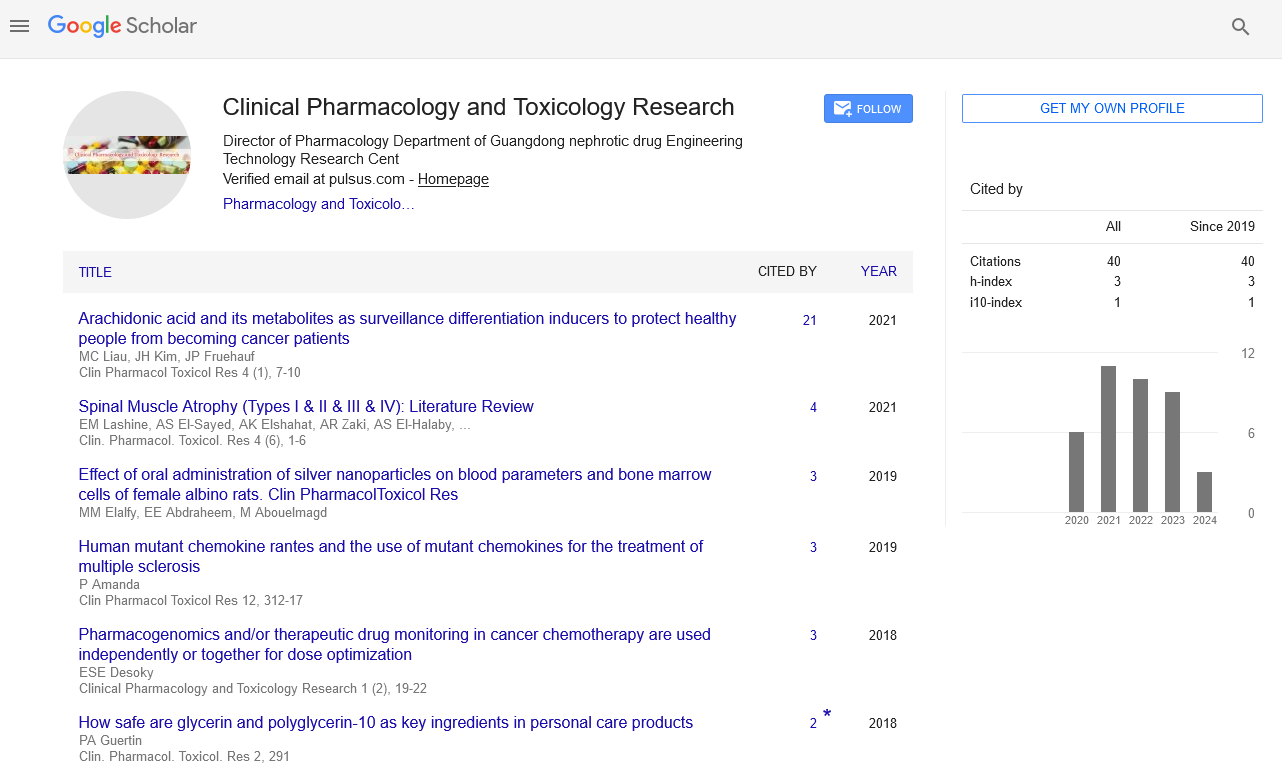Clinical pharmacology and toxicology research-2020 highlights
Received: 08-Apr-2000 Accepted Date: Apr 15, 2000; Published: 22-Apr-2000
Citation: Stark MC. Clinical pharmacology and toxicology research-2020 highlights. Clin Pharmacol Toxicol Res 2020;3(1):4-5
This open-access article is distributed under the terms of the Creative Commons Attribution Non-Commercial License (CC BY-NC) (http://creativecommons.org/licenses/by-nc/4.0/), which permits reuse, distribution and reproduction of the article, provided that the original work is properly cited and the reuse is restricted to noncommercial purposes. For commercial reuse, contact reprints@pulsus.com
Editorial Note
On behalf of the Board of Clinical Pharmacology and Toxicology Research (CPTR), I am glad to present the Volume 4, Issue 1 of the journal. The journal established in 2017 has now published 6 issues with two issues in a year. Articles published in our journal are getting more citations and exposure all around the world. All these are promising signs. We could reach this stage through the constant support of Board Members and intellectual generosity of the readers and contributors (authors and reviewers). One of the objectives of this journal is to encourage publication from different streams of research that helps to enrich further the discourse on clinical pharmacology and toxicology research [1].
First and foremost, I express heartfelt to all authors and reviewers of the 4th year of Clinical Pharmacology and Toxicology Research (CPTR), on behalf of the entire editorial board and the publisher. It was with the mere co-operation, enthusiasm, and spirit of the authors and reviewers we could make CPTR a grand success [2].
CPTR Journal is the most preferred and highly accessed Journal in the field of Clinical Pharmacology and Toxicology Research. The Journal is indexed in Google scholar, Index Copernicus, CNKI and Scholar among many other reputed scientific databases. At many instances’ members of the editorial board also prefer to submit their articles. Such practice is common in other reputed specialty Journals. In fact, journal encourages editorial board members to actively contribute [3]. All scientific manuscripts including editorials are subjected to peer review. Journal follows a double-blind peer review process where identity of authors and reviewers is not revealed to each other. The review generally involves two to six subject experts. The editorial team consisting of associate editors and assistant editors are involved in the entire article cycle starting from submission to final recommendation. The entire review process is carefully structured so as to minimize possibility of bias [4].
Clinical Pharmacology and Toxicology Research calls on leading scientists and scholars around the world including but, not limited to the following fields: Biochemical pharmacology, Cancer Pharmacology, Molecular and cellular pharmacology, Pharmacology, Structural biology, Cardiovascular Toxicology, Cardiovascular Pharmacology, Clinical Drug Trials, Clinical Pharmacists, Clinical Pharmacology, Clinical Research Studies, Clinical Trials Databases, Medical Trails/ Drug Medical Trails, Methods in Clinical Pharmacology, Pharmacoeconomics.
We are seeking to increase the number of quality manuscripts submitted to CPTR by providing frequent and targeted communication to interested authors about the journal. We will use both traditional methods (e.g., contact at professional association meetings) and emerging methods (e.g., social media and e-mail lists) to reach potential authors [5].
The goal of increasing the number of quality submissions relates to another goal, the inclusion of CPTR in pertinent databases and indexing systems.
Useful tips have been proposed to aid effective use of the social media in promoting research and increasing visibility of the one's work
Linkedin: It is a professional networking platform. You can use it share updates on your research or a paper in a specific group or publicly. You can also provide links to your blogs, articles, websites, and more.
Mendeley: This platform can help you grow your network by joining groups of your interest. You cannot only view your research impact but also view others popular works.
ResearchGate: It is a social networking platform especially for scientists and researchers to share and interact on research topics. It can also be used effectively to collaborate with other researchers on a common interest area.
We look forward to work with all of you as we continue to make Clinical Pharmacology and Toxicology Research a success and we welcome your submissions, as well as feedback as authors, readers, and reviewers of the journal.
I would also like to express my gratitude to all the authors, reviewers, the publisher, the advisory and the editorial board of CPTR, the office bearers and staff for their support in bringing out yet another volume of CPTR and look forward to their unrelenting support to bring out the Volume 4 of CPTR
REFERENCES
- Cooper SS, Terekhov IV. Influence of low-intensity microwave radiation with a frequency of 1 ghz on the functional status of mononuclear leukocytes of whole blood in practically healthy young faces. Clin Pharmacol Toxicol Res. 2016;5:1083-87.
- Amanda P. Human mutant chemokine rantes and the use of mutant chemokines for the treatment of multiple sclerosis. Clin Pharmacol Toxicol Res. 2019;12:312-17.
- Moskalev AV.The role of chemokines in the development of an antiviral immune response Clin Pharmacol Toxicol Res. 2017;3:183-88.
- Esche C, Stellato C, Beck LA. Chemokines: Keyplayers in innate and adaptive immunity. Clin Pharmacol Toxicol Res. 2018;125:615-28.
- Loetscher P,Seitz M, Clark-Lewis I, et al. Activation of NKcells by CC chemokines. Chemotaxis, Ca2+ mobilization, and enzyme release. Clin Pharmacol Toxicol Res. 2017;156:322-27.





